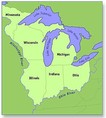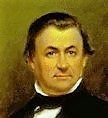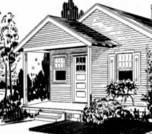 1800   President John Adams signed the Harrison Land Act which allowed settlers to purchase property in the Northwest Territory on credit. The new law, named for its author, William Henry Harrison, allowed buyers to purchase 320 acres for a 25% down payment. The remainder would be due in installments spread over four years.  The price was set at two dollars an acre.  As a result, many more people were able to purchase property and migrate into the territory. 1800   President John Adams signed the Harrison Land Act which allowed settlers to purchase property in the Northwest Territory on credit. The new law, named for its author, William Henry Harrison, allowed buyers to purchase 320 acres for a 25% down payment. The remainder would be due in installments spread over four years.  The price was set at two dollars an acre.  As a result, many more people were able to purchase property and migrate into the territory. |
 1846   President James Polk declared war on Mexico. Three days later, the Secretary of War called on Indiana Governor James Whitcomb to supply three regiments of infantry or riflemen, a total of approximately 3,000 men.  The quota was met within three weeks.  Volunteers responded to recruiting meetings in cities all around the state.  Hoosier women also became heavily involved, making uniforms, banners and flags.  The soldiers were sent to Camp Clark near New Albany for training. Brigadier General Joseph Lane was placed in charge. 1846   President James Polk declared war on Mexico. Three days later, the Secretary of War called on Indiana Governor James Whitcomb to supply three regiments of infantry or riflemen, a total of approximately 3,000 men.  The quota was met within three weeks.  Volunteers responded to recruiting meetings in cities all around the state.  Hoosier women also became heavily involved, making uniforms, banners and flags.  The soldiers were sent to Camp Clark near New Albany for training. Brigadier General Joseph Lane was placed in charge. |
 1869   At a special session called by Governor Conrad Baker, the Indiana General Assembly passed a law that admitted African American children to public schools.  The legislation said, “In assessing taxes for school purposes, there shall be no omissions or distinctions made on account of race or color; but each and every person’s property, of every kind or description, shall be assessed the same as any other person’s property for the same purpose.† The state left it up to each community to carry out the provisions of the new law. 1869   At a special session called by Governor Conrad Baker, the Indiana General Assembly passed a law that admitted African American children to public schools.  The legislation said, “In assessing taxes for school purposes, there shall be no omissions or distinctions made on account of race or color; but each and every person’s property, of every kind or description, shall be assessed the same as any other person’s property for the same purpose.† The state left it up to each community to carry out the provisions of the new law. |
 1884   Paris C. Dunning died in Bloomington. He had served as the ninth Governor of Indiana (1848-1849.) He had also been an Indiana House member, Indiana Senator, Senate President Pro Tempore, and Lieutenant Governor. He is the only person in state history to have served in all of these offices.  As governor, he led the Indiana General Assembly in passing a resolution sent to Congress which opposed the expansion of slavery across the United States. 1884   Paris C. Dunning died in Bloomington. He had served as the ninth Governor of Indiana (1848-1849.) He had also been an Indiana House member, Indiana Senator, Senate President Pro Tempore, and Lieutenant Governor. He is the only person in state history to have served in all of these offices.  As governor, he led the Indiana General Assembly in passing a resolution sent to Congress which opposed the expansion of slavery across the United States. |
 1911   The Studebaker Company introduced the latest model of their electric car. “It gives time to think from streetcar crowds and street annoyances,†the ad said, “and goes anywhere, anytime, to the theater, about town, into the country.â€Â The company, based in South Bend, had become famous for its wagons and carriages. Electric cars were produced from 1902 until 1912, when production turned to gasoline engines. The electric model had four speeds and could go up to 18 mph. 1911   The Studebaker Company introduced the latest model of their electric car. “It gives time to think from streetcar crowds and street annoyances,†the ad said, “and goes anywhere, anytime, to the theater, about town, into the country.â€Â The company, based in South Bend, had become famous for its wagons and carriages. Electric cars were produced from 1902 until 1912, when production turned to gasoline engines. The electric model had four speeds and could go up to 18 mph. |

100 Years Ago
1922   The first Indianapolis Home Show was held in the Manufacturers Building at the Indiana State Fairgrounds. Officially called the “Home Complete Exposition,” the event invited visitors to see over 100 exhibits and to walk through a five-room bungalow which had been built inside the building. One of the most popular demonstrations introduced automatic garage doors which went up and down at the push of a button. The show was sponsored by the Indianapolis Real Estate Board. (See “Extra” in the right column)
|
Follow this link to subscribe to Hoosier History Highlights and to view archived editions
Follow us on Instagram: @instatehousetouroffice
|



 1800   President John Adams signed the Harrison Land Act which allowed settlers to purchase property in the Northwest Territory on credit. The new law, named for its author, William Henry Harrison, allowed buyers to purchase 320 acres for a 25% down payment. The remainder would be due in installments spread over four years.  The price was set at two dollars an acre.  As a result, many more people were able to purchase property and migrate into the territory.
1800   President John Adams signed the Harrison Land Act which allowed settlers to purchase property in the Northwest Territory on credit. The new law, named for its author, William Henry Harrison, allowed buyers to purchase 320 acres for a 25% down payment. The remainder would be due in installments spread over four years.  The price was set at two dollars an acre.  As a result, many more people were able to purchase property and migrate into the territory. 1846   President James Polk declared war on Mexico. Three days later, the Secretary of War called on Indiana Governor James Whitcomb to supply three regiments of infantry or riflemen, a total of approximately 3,000 men.  The quota was met within three weeks.  Volunteers responded to recruiting meetings in cities all around the state.  Hoosier women also became heavily involved, making uniforms, banners and flags.  The soldiers were sent to Camp Clark near New Albany for training. Brigadier General Joseph Lane was placed in charge.
1846   President James Polk declared war on Mexico. Three days later, the Secretary of War called on Indiana Governor James Whitcomb to supply three regiments of infantry or riflemen, a total of approximately 3,000 men.  The quota was met within three weeks.  Volunteers responded to recruiting meetings in cities all around the state.  Hoosier women also became heavily involved, making uniforms, banners and flags.  The soldiers were sent to Camp Clark near New Albany for training. Brigadier General Joseph Lane was placed in charge. 1869   At a special session called by Governor Conrad Baker, the Indiana General Assembly passed a law that admitted African American children to public schools.  The legislation said, “In assessing taxes for school purposes, there shall be no omissions or distinctions made on account of race or color; but each and every person’s property, of every kind or description, shall be assessed the same as any other person’s property for the same purpose.† The state left it up to each community to carry out the provisions of the new law.
1869   At a special session called by Governor Conrad Baker, the Indiana General Assembly passed a law that admitted African American children to public schools.  The legislation said, “In assessing taxes for school purposes, there shall be no omissions or distinctions made on account of race or color; but each and every person’s property, of every kind or description, shall be assessed the same as any other person’s property for the same purpose.† The state left it up to each community to carry out the provisions of the new law. 1884   Paris C. Dunning died in Bloomington. He had served as the ninth Governor of Indiana (1848-1849.) He had also been an Indiana House member, Indiana Senator, Senate President Pro Tempore, and Lieutenant Governor. He is the only person in state history to have served in all of these offices.  As governor, he led the Indiana General Assembly in passing a resolution sent to Congress which opposed the expansion of slavery across the United States.
1884   Paris C. Dunning died in Bloomington. He had served as the ninth Governor of Indiana (1848-1849.) He had also been an Indiana House member, Indiana Senator, Senate President Pro Tempore, and Lieutenant Governor. He is the only person in state history to have served in all of these offices.  As governor, he led the Indiana General Assembly in passing a resolution sent to Congress which opposed the expansion of slavery across the United States. 1911   The Studebaker Company introduced the latest model of their electric car. “It gives time to think from streetcar crowds and street annoyances,†the ad said, “and goes anywhere, anytime, to the theater, about town, into the country.â€Â The company, based in South Bend, had become famous for its wagons and carriages. Electric cars were produced from 1902 until 1912, when production turned to gasoline engines. The electric model had four speeds and could go up to 18 mph.
1911   The Studebaker Company introduced the latest model of their electric car. “It gives time to think from streetcar crowds and street annoyances,†the ad said, “and goes anywhere, anytime, to the theater, about town, into the country.â€Â The company, based in South Bend, had become famous for its wagons and carriages. Electric cars were produced from 1902 until 1912, when production turned to gasoline engines. The electric model had four speeds and could go up to 18 mph.






